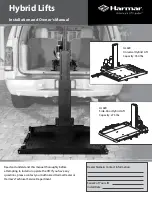
Chapter 12
LQG/H-Infinity Synthesis
©
National Instruments Corporation
12-15
Xmath Interactive Control Design Module
Here
is a square matrix such that
and
is a square matrix such that
The H
∞
solution is defined as the one that minimizes the maximum singular
value of the transfer function from
w
n
to
z
n
.
The only difference in the user interface with the LQG design is that the
decay rate option cannot be selected. The reason for this is that the solution
does not have a separation property like the LQG solution, which is
required for the implementation of a guaranteed decay rate. Another
difference is that certain parts of the combined closed-loop system are not
allowed to have zeros on the imaginary axis. If that is the case, an error
message is reported in a window.
When the H
∞
performance level
γ
is large, the H
∞
controller is
approximately the same as the LQG controller. By reducing
γ
with the
slider or by dragging the horizontal dashed line in the singular value plot,
the algorithm will decrease the maximal singular value to its lower bound.
For practical H
∞
design, the following should be considered. In order to
achieve the lower bound, the H
∞
algorithm will sometimes place the
controller poles very far to the left in the complex plane.
Also, the gain at high frequencies is often increased significantly, which
increases the noise sensitivity.
Therefore, a better control performance is often obtained by trying to lower
the H
∞
norm not to its absolute minimum, but rather to a slightly larger
value.
Q
ww
1
2
---
Q
ww
Q
ww
T
2
---
Q
ww
1
2
---
=
R
zz
1
2
---
R
zz
R
zz
T
2
---
R
zz
1
2
---
=
















































